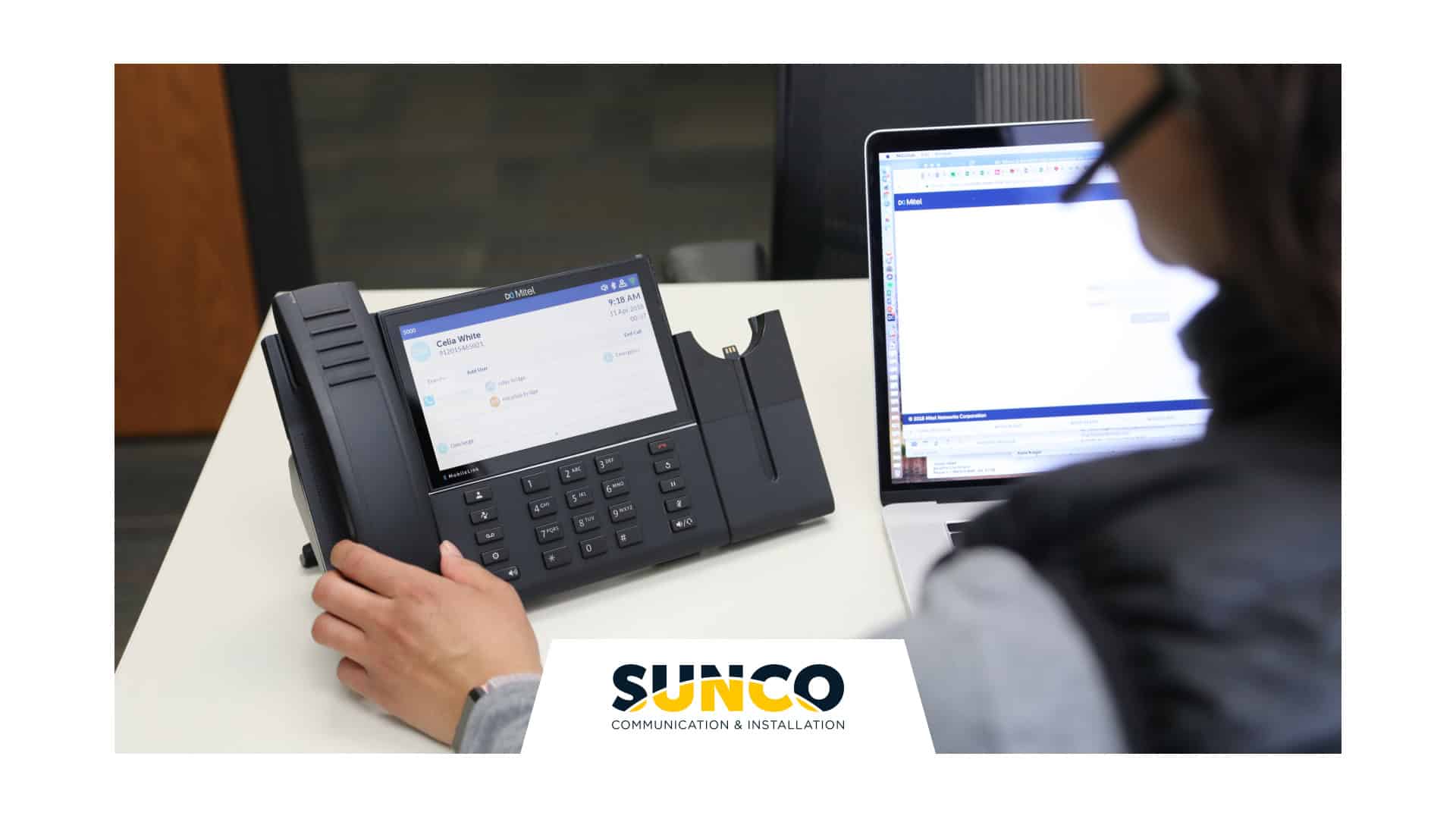Small businesses should use multi-line phone systems to enhance their call-handling capacity and prevent potential loss of business. Since approximately 72 to 80% of callers will hang up without leaving a voicemail if their call isn’t answered, having a system that can handle multiple calls simultaneously reduces the risk of missing important calls.
| “No matter your phone line’s technical call quality, customer perception will always be improved by timely calls and friendly agents.” – Sean Schoenberger, President, Sunco Communication & Installation |
A multi-line system also leads to fewer callers hanging up due to long wait times. Good customer service can set a business apart from competitors and shorter wait times increase a customer’s perception of good service. Today, we’ll take a closer look at what multi-line phones offer.
What Are Multi-Line Phone Systems?
Multi-line phone systems are comprehensive communication networks that allow multiple phone lines to operate through a single device or network of phones.
For small businesses, managing multiple calls simultaneously isn’t just about efficiency—it’s about delivering a professional, polished customer experience. When customers aren’t left waiting or sent to voicemail unnecessarily, and calls are quickly directed to the right person, you build trust and credibility essential for business growth. Beyond that, multi-line systems streamline internal communication, minimize missed opportunities, and project professionalism typically associated with larger enterprises.
With over 30 years of industry experience, Sunco has helped businesses across Canada elevate their business phone systems and communication capabilities, as well as adapting DECT or Digital Enhanced Cordless Telecommunications.
How Do Multi-Line Phone Systems Work?
Here’s the step-by-step process of how multi-line phone systems work:
- An inbound call comes to your business
- The multi-line system scans for an open line
- If a line is available, the call connects immediately
- If all lines are busy, the system holds the call or routes it to voicemail
- You can transfer calls, place them on hold, or manage multiple conversations simultaneously across different lines
What makes modern multi-line systems particularly powerful is their integration with VoIP (Voice over Internet Protocol) services. This technology enables your team to make and receive calls using internet-connected devices, providing the flexibility today’s businesses need.
With Sunco’s guaranteed 99.9% uptime and 24/7 customer support, your communications remain stable and reliable—backed by a Canadian telecom leader with over three decades of industry expertise.
Learn More About How You Can Enhance Your Phone Services |
Types of Multi-Line Phone Systems
Here’s a breakdown of the main multi-line phone system types:
- Traditional Multi-Line Systems (Analog): These systems utilize physical phone lines such as handset and cordless phones and typically integrate into desk phones with two or more lines. Common configurations include:
-
- 2-Line Phones: Perfect for home offices or solopreneurs with handsets needing to separate personal and business calls
- 4-Line Phones: Ideal for small offices with several employees handling moderate call volumes
- 6–12-Line Phones: Optimal for busy reception areas or businesses with multiple departments requiring direct access
- IP PBX (Private Branch Exchange) Systems: IP PBX systems route calls over the internet using internal servers, offering greater flexibility than analog systems. They’re excellent for small to mid-sized businesses wanting more control and advanced features like customizable call routing, voicemail-to-email, and department extensions. These systems can handle dozens of lines and devices, making them ideal for growing businesses that want in-house infrastructure without sacrificing modern functionality.
- Cloud-Based (Hosted) Phone Systems: Cloud-based systems represent the most expandable and cost-effective option available today. Everything operates through the internet, eliminating the need for bulky hardware or complex installations. You can easily add or remove lines, integrate with CRM platforms, and manage calls from any device—perfect for remote or hybrid teams. With cloud systems, you only pay for what you use, and upgrades happen automatically. They’re specifically designed to scale with your business while keeping costs predictable.
Traditional vs. Cloud Systems
Traditional multi-line phone systems operate on physical landlines or private branch exchange (PBX) infrastructure. They’re typically installed on-site and connected to desk office phones using internal wiring.
Pros:
- Reliable and time-tested technology
- Excellent for businesses in areas with limited internet access
- No dependency on internet bandwidth or connectivity
Cons:
- Higher upfront costs for hardware and installation
- Limited flexibility—difficult to scale or add remote users
- Fewer advanced features (like software integrations or mobile applications)
- Maintenance typically requires on-site technical phone service
Cloud-based multi-line systems, meanwhile, utilize DECT internet connectivity to handle calls, eliminating the need for on-site servers, reducing hardware costs, and enabling access from virtually anywhere.
Pros:
- Lower initial investment with predictable monthly costs
- Easy scalability—add or remove users with minimal effort
- Advanced features including automated call routing, call recording-to-email, mobile accessibility, and CRM integration
- Ideal for supporting remote or hybrid work environments
- Automatic updates with minimal maintenance requirements
Cons:
- Dependent on stable internet connectivity
- May require network upgrades if bandwidth is limited
Sunco partners with trusted telecom phone service providers like Mitel, Telus, Rogers, and Shaw to bring you reliable, high-performance systems—whether traditional or cloud-based.
5 Key Benefits of Multi-Line Business Phone Systems for Businesses
1. Fewer Missed Calls, Shorter Wait Times
With the ability to handle multiple calls simultaneously, multi-line systems dramatically reduce missed opportunities. Instead of callers encountering busy signals or being sent to voicemail, phone calls are routed efficiently—minimizing wait times and ensuring more conversations convert to business. Considering the average small business misses up to 62% of inbound calls, this feature alone can significantly boost responsiveness and revenue.
2. Cost-Effective Communication
Multi-line telephone systems represent a smart investment for budget-conscious businesses. Cloud-based options particularly offer predictable monthly pricing with minimal upfront hardware costs. With built-in features like customizable voicemail, caller ID, and call forwarding, there’s no need to pay extra for functionality that should be standard. You get enterprise-grade tools without the enterprise-level price.
3. Scalable for Growth
Effective internal communication is as crucial as customer service. Multi-line systems enable employees to transfer calls, involve colleagues, or manage multiple conversations—whether in the office or working remotely. This improves team efficiency, reduces call accelerates decision-making, and enhances collaboration across departments.
4. Stronger Internal Collaboration
Effective internal communication is as crucial as customer service. Multi-line systems enable employees to transfer calls, involve colleagues, or manage multiple conversations—whether in the office or working remotely. This improves team efficiency, reduces call accelerates decision-making, and enhances collaboration across departments.
5. Professional Presence from Day One
First impressions matter significantly. Features like auto-attendants, customized greetings, and intelligent call routing give even the smallest business a polished, professional image. Customers experience consistent, high-quality service—building trust, credibility, and loyalty from their very first interaction.
Advanced Features to Consider
When selecting a multi-line phone system, consider more than just line capacity—focus on features that help your business operate more efficiently and professionally. Here are the advanced features to consider:
Auto Attendant
Greet every caller with a professional, automated menu that directs them to the appropriate department or team member—without requiring a dedicated receptionist.
Call Forwarding
Never miss important calls, even away from your desk. Call forwarding routes calls to mobile phones, alternative locations, or backup team members, ensuring continuous connectivity regardless of location.
Call Analytics
Understand when call volumes peak or how quickly your team responds with comprehensive call analytics. These insights into call patterns, missed opportunities, and performance metrics enable data-driven decisions that improve customer service.
Call Hold & Call Parking
Place calls on hold with custom music or messaging, or “park” a call for another team member to retrieve from a different phone—perfect for front-desk and customer service operations.
Business Voicemail
Business-grade voicemail offers more than basic message recording. With features like voicemail-to-email delivery, customized greetings, and streamlined message management, you’ll capture important information and respond more efficiently.
How to Set Up a Multi-Line Phone System
-
Assess Your Business Needs
Start by evaluating your line requirements and essential features (e.g., call forwarding, voicemail, auto attendant). Consider both current needs and future growth plans. -
Choose the Right System Type Decide between a traditional on-premise system or a cloud-based solution. Cloud systems provide greater flexibility, easier scalability, and typically lower upfront costs.
-
Select Your Equipment Depending on your chosen system, you’ll need compatible devices such as:
- Multi-line desk phones or cordless phones (2, 4, or 6–12 line models)
- Internet-enabled handsets for VoIP/cloud systems
- Headsets or conferencing speakerphones for specific roles
- Network hardware (routers/switches) if implementing a cloud or IP PBX system
-
Install and Configure the System Your system will connect multiple lines through a central platform. Configuration includes:
- Assigning extensions
- Setting up call routing rules
- Recording auto messages
- Customizing voice mail settings
- Enabling mobile or remote access features (for cloud-centred systems)
Integrating with Existing Systems
Smooth Integration with VoIP and Business Tools
Cloud and IP-enabled multi-line systems work seamlessly with today’s popular business technologies. Connect your phone system to:
- CRM software (like Salesforce or HubSpot) for automatic call information and tracking
- VoIP platforms for internet-based calling and remote accessibility
- Email and messaging tools for direct voicemail delivery to inboxes
- Collaboration apps (like Microsoft Teams) to unify internal communications
This integration ensures your team manages calls, client records, and follow-ups from a single interface—improving productivity and saving valuable time.
Flexible Communication, Anywhere
Integrated multi-line systems simplify call management whether your team works in the office, remotely, or on the move. With softphones, mobile applications, and browser-based call handling, your business maintains responsiveness regardless of where work happens.
A Unified, Professional Presence
Integration provides more than phone service convenience—it ensures consistency. With aligned communication channels, you deliver seamless, professional experiences to every caller. From automated greetings to personalized service, your brand voice remains consistent across all interactions.
Choosing the Right Multi-Line Phone System for Your Business
Start with Your Business Size and Structure
- Solo or Small Teams: A simple 2- to 4-line handset system may sufficiently manage customer inquiries and internal communication.
- Growing Businesses: Consider scalable solutions with cloud capabilities, allowing easy addition of lines, users, and features as operations expand.
- Multi-Location Operations: Look for systems with centralized management and VoIP integration to unify communication across offices and remote teams.
Identify Your Must-Have Features
Do you need automation, mobile access, or CRM integration? Advanced telephone systems allow customization of everything from call routing to analytics dashboards.
Keep Budget and Flexibility in Mind
Today’s multi-line systems are more affordable than ever. Cloud-based options particularly offer flexible monthly pricing with minimal hardware investment. You receive enterprise-grade functionality without enterprise-level costs, plus the freedom to scale according to business needs.
Work with a Trusted Partner
As a Microsoft Silver Partner and certified telecom provider, Sunco helps businesses across Canada find communication solutions that truly meet their needs.
Evaluating Business Needs
Start with the Basics: Team Size and Call Volume
Consider how many employees need phone line access and typical simultaneous call volume. Smaller businesses might only require 2- or 4-line systems, while companies experiencing growth—or those in high-contact industries like legal, healthcare, or real estate—may benefit from systems supporting 6 to 12+ lines.
Analyze Daily Communication Flow
Ask these important questions:
- Do we regularly transfer calls between departments?
- How frequently are calls missed or directed to voicemail?
- Are we consistently providing professional greetings to clients?
Consider Remote Work and Future Growth
If your team works from multiple locations or needs connectivity while traveling, cloud-based systems and VoIP integrations provide unmatched flexibility. As your business expands, a scalable system allows adding new lines and users without starting over.
Custom Solutions Make a Difference
At Sunco, our telecom specialists work directly with you to design systems tailored to your specific workflow and growth trajectory, corded or not, ensuring smoother collaboration and improved caller experiences.
Frequently Asked Questions
How Many Lines Can I Have?
System capacity varies by solution. Entry-level options support 2 to 4 lines, perfect for small teams, while advanced systems accommodate 6 to 12+ lines. Cloud-dependent systems offer virtually unlimited scalability, allowing your phone infrastructure to grow alongside your business.
Do I Need New Equipment?
Not necessarily. Many modern multi-line systems work with existing hardware—especially when upgrading to cloud solutions.
Will This Work for Remote or Hybrid Teams?
Absolutely. Cloud and VoIP-based multi-line systems are specifically designed for mobility. Your team can handle calls from any location using softphones, mobile applications, or web browsers—while accessing all business phone system features.
Can I Keep My Current Phone Number?
Absolutely. Maintaining your existing phone number when transitioning to a multi-line phone system is not only possible but standard practice.
Sunco makes this transition seamless through number porting, allowing your business to continue using established contact information while upgrading to a more flexible, modern communication system. Here’s how it works.
- We confirm your current provider and number details
- Sunco submits the porting request on your behalf
- Your number transfers seamlessly to the new system—typically within a few business days
- You continue using your familiar number with all the enhanced features of your new multi-line setup.
How do I Transfer Calls on a Multi-Line Phone?
- Answer the Incoming Call: Respond to the call normally
- Put the Call on Hold: Press the Hold button to maintain the connection while preparing the transfer
- Select the Line for Transfer: Choose the appropriate extension or department line
- Transfer the Call: Press the Transfer button and dial the extension or department number
- Announce the Call (Optional): If supported, speak with the recipient before completing the transfer
- Complete the Transfer: Press Transfer again to finalize, connecting the caller to the appropriate person.
Multi-Line Phone Systems vs. Single-Line Phone Systems
Multi-line phone systems are generally the best option for business use. However, there are some edge cases where the single-line system may be the right choice. While multi-line systems offer versatility for growing businesses, single-line systems can be more straightforward and cost-effective for those with simple needs.
Here is a table providing a quick comparison of the two.
| Multi-Line | Single Line | |
| Call Volume | Can manage multiple calls simultaneously, reducing wait times. | Limited to one call at a time, potentially leading to missed calls. |
| Initial Cost | Higher initial investment but offers more features and flexibility. | Lower, but lacks flexibility and advanced features. |
| Technical Complexity | Slightly more complex and may require some training for proper use. | Simple and straightforward to use. |
| Functionality | Advanced features like call transferring, conference calling, and automated attendants. | Basic functionality suitable for straightforward call handling. |
| Flexibility in Operations | Enables flexible handling of customer inquiries and internal communication. | More rigid, suitable for direct calls with no need for rapid redirections. |
| Maintenance | Potentially higher maintenance costs and updates. | Lower maintenance and straightforward upkeep. |
| Ideal Use Case | Ideal for any business with high call traffic, multiple departments, or the need for advanced communication tools. | Only suitable for small businesses or emerging startups with limited call handling needs, a small team, and simple operations. |
Enhancing Business Communication with Sunco Communications and Installation
Upgrading from single-line to multi-line phone systems represents a significant improvement for small businesses, with benefits that substantially outweigh initial concerns.
Reduced Costs: Cloud phone systems typically utilize existing devices without requiring expensive infrastructure, lowering initial expenses.
No Maintenance Hassles: Service providers typically handle maintenance as part of your subscription.
Scalability & Flexibility: Cloud systems grow seamlessly with your business. Add lines as your team expands and adjust system capabilities to meet evolving needs without complex reconfiguration or significant additional investment.
Enhanced Communication: Multi-line systems improve phone call management by minimizing missed calls and wait times, boosting both internal teamwork and customer satisfaction.
With over three decades of industry experience, award-winning service, and recognition as a trusted systems integrator, Sunco Communication & Installation expertly guides businesses through communication transitions. Our strategic partnerships with leading VoIP and DECT providers, including Mitel, Telus, Rogers, and Shaw, enable us to offer optimal solutions tailored to your specific business requirements.
Contact us today to discover how a multi-line phone system can streamline communication, enhance your professional image, and optimize your business operations.






